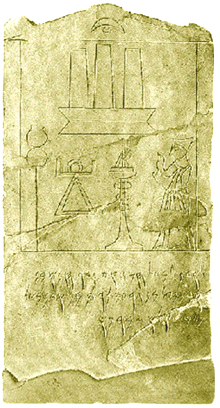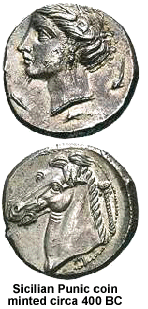...Best of Sicily presents... Best of Sicily Magazine. ... Dedicated to Sicilian art, culture, history, people, places and all things Sicilian. |
by Vincenzo Salerno | |||||
Magazine Index Best of Sicily Arts & Culture Fashion Food & Wine History & Society About Us Travel Faqs Contact Map of Sicily
|
Western Sicily bears traces of the Carthaginian presence, particularly in the Punic walls of Palermo and Erice, and of course the archeological sites at Mozia and Marsala. A number of Carthaginian artworks and inscriptions (such as the stela shown here) are preserved in Sicilian museums. In Sicily, Greek and Roman structures were built upon most of the Phoenician and Carthaginian ones, leaving little superstructure comparable to the island's majestic Greek temples or Roman amphitheatres. The word "Punic" (Latin Poenicus and later Punicus) refers to the civilization of Carthage, its language and art, and derives from the Greeks' word Phoinikes, meaning "Phoenician." Initially, Carthage was Phoenician in every sense, and its importance --as well as its population-- grew with the political decline of Phoenicia,
eventually becoming the largest Phoenician city. It is quite possible that
the Phoenicians were already present in northeastern Tunisia as While this "residual" civilization remained essentially Phoenician over the centuries, some minor "indigenous" African influences were evident by 500 BC, complemented by local developments which eventually made Carthage somewhat distinct from the societies of Phoenicia. "Ethnic drift" of this kind is normal, and in time Carthage emerged as a city-state, and mini-empire, in its own right. By 500 BC, as Phoenicia fell to the Persians, Carthage emerged as a regional power, falling into open conflict with the Greeks. Greek antipathy pre-dated the Phoenicians' forced alliance with the Persians against Greece. This led to some interesting developments, such as the alliance of Carthage with the Etruscans of central Italy. Etruscan power declined after 500 BC, and the emerging Romans looked to the Greeks as a cultural influence. The cities of Zis (Palermo) Solus (Solunto), Lilybaeum (Marsala) and Motya (Mozia) were the most important Carthaginian centres in Sicily, inherited by Carthage from their ancestors (the "original" Phoenicians), though Eryx (Erice) and other cities were certainly influenced by Phoenician and Carthaginian culture. It was not unusual for certain Greek cities of western Sicily to trade with the Carthaginians despite an official state of war. The city of Syracuse, Sicily's largest and most important Greek city, exercised a particularly anti-Carthaginian policy, but could not always dissuade Selinus (Selinunte) from entering into alliance with the Carthaginians. Unfortunately, the Carthaginians have often been portrayed in an unfairly negative light. Intrinsically, however, the Greeks and Romans had no more right than the Carthaginians to colonize Sicily or any other place, and enjoyed no moral superiority to them. Indeed, they, not the Carthaginians, were often the aggressors. Each had colonies in France and Spain, and neither was prepared to allow Carthage free control of the central and western Mediterranean, including the Strait of Gibraltar. This was pure hegemony in its worst form. In many respects, the cultures of the Carthaginians, Greeks and Romans --and even the people themselves-- were remarkably similar. Roman culture owed much to Hellenic culture, and the Greeks had been strongly influenced by the Phoenicians. Objectively speaking, there is no historical indication that the few Carthaginian cities of Sicily were any less prosperous than the Greek ones. For the purpose of defining their role in central Mediterranean history,
and their ethnic identity as a people, we may say that the Carthaginians
constituted a society in significant ways In 580 BC, around the time the Phoenicians and Persians were defeated at Salamis in Greece, the Carthaginians suffered a serious defeat by Syracusan troops at the battle of Himera, east of Palermo. At home, Carthage gradually evolved from a form of monarchy into an oligarchy. By 410 BC, Carthage was again expanding into Sicily, where Selinus and Himera were attacked and essentially destroyed the following year. Not surprisingly, problems with the Siceliots (Greek Sicilians) were to continue, but a truce was established in 392 BC by Dionysos I, a Syracusan general and tyrant (leader). In 341 BC, Corinthian and Syracusan troops defeated a Carthaginian force at the battle of the River Crimisus. This, however, served to check Carthaginian influence only temporarily. Agathocles, a later leader of Syracuse, having lost an earlier battle against the Carthaginians, invaded north Africa in 310 BC, but this was not the end Carthage. The arrival of the Mamertines at Messina in 289 signaled the earliest Roman inroads into Sicily. The Syracusans formed an alliance with the Romans against the Carthaginians, but Syracuse itself fell to a Roman invasion in 212 BC, despite the aid of the brilliant Archimedes. The task of defeating the Carthaginians now fell to the Romans. It was not an easy or simple matter. The First Punic War (264-241 BC) had resulted in a marginal victory, though the power of both Syracuse and Carthage were checked and the Strait of Messina brought under Roman control. Hamilcar Barca. In 254 BC the Romans defeated Carthaginian forces in Panormos (Palermo). In 251, a second battle was fought at Palermo, this time against Carthaginians led by Hamilcar Barca in fighting just outside the city. Again, the Romans were victorious. With the Sicilian Greeks seemingly defeated, the Second Punic War (218-201 BC) concentrated on Carthage and her cities in Iberia (Spain). An unexpected revolt in Syracuse in 211 was put down. This was a diversion, as the Second Punic War obviously was not an exclusively Sicilian conflict. Rival Carthaginian-Roman claims in Iberia and the western Mediterranean were the real issue. It was in this war that the general Hannibal (son of Hamilcar) crossed the Alps with an army of Carthaginians and Gauls (and elephants as well as horses) to confront a Roman and Sicilian force. He was defeated at Zama (in Africa) in 202 BC and Carthage lost her Iberian colonies. For a time, Rome allowed defeated Carthage a degree of autonomy. A Third Punic War broke out in 149 BC, only to result in the destruction of Carthage in 146 BC. Tragically, this meant the violent death or enslavement of thousands of men, women and children, and the effective end of classical Carthaginian civilization. Carthage eventually re-emerged as a city of the Roman Empire, preserving some vestige of its former culture. In the Christian era, it was home to Saint Augustine. Utica (which sided with Rome in the Third Punic War), not Carthage, became the capital of Rome's colony of Africa. What was left of Carthage was sacked by Vandals in AD 430. In 698 it was finally destroyed by Arabs during the Muslim Arab migration westward across north Africa and into Sicily and Spain. The Carthaginians cannot be said to have contributed as much to Western Civilization as the Greeks or the Romans. Yet, they nearly defeated both, and we cannot know what the Carthaginians might have achieved if they could have spent more time nurturing their society instead of constantly defending it. About the Author: Palermo native Vincenzo Salerno has written biographies of several famous Sicilians, including Frederick II and Giuseppe di Lampedusa. | ||||
Top of Page |
 Carthage, near
modern Tunis, was founded around 800 BC (BCE) by
Carthage, near
modern Tunis, was founded around 800 BC (BCE) by  early as 1100 BC. Utica,
near Carthage, was probably their first settlement in the region and in
Roman times did not always find itself in harmony with its larger neighbor.
early as 1100 BC. Utica,
near Carthage, was probably their first settlement in the region and in
Roman times did not always find itself in harmony with its larger neighbor. distinctive of Phoenician
society beginning around 500 BC. (Admittedly, this is not a perfect means
of distinguishing the latter Carthaginians from their mother culture, but
it coincides with other key developments, such as the re-colonization of
Zis and other Sicilian localities established earlier by the Phoenicians;
it also corresponds with the emergence of the Carthaginians as colonizers
rather than traders, and with certain social movements in Carthage. Though
the distinction between Phoenicians and Carthaginians was primarily social
rather than genetic, Phoenician populations were known to amalgamate to
some extent with "native" peoples such as
distinctive of Phoenician
society beginning around 500 BC. (Admittedly, this is not a perfect means
of distinguishing the latter Carthaginians from their mother culture, but
it coincides with other key developments, such as the re-colonization of
Zis and other Sicilian localities established earlier by the Phoenicians;
it also corresponds with the emergence of the Carthaginians as colonizers
rather than traders, and with certain social movements in Carthage. Though
the distinction between Phoenicians and Carthaginians was primarily social
rather than genetic, Phoenician populations were known to amalgamate to
some extent with "native" peoples such as